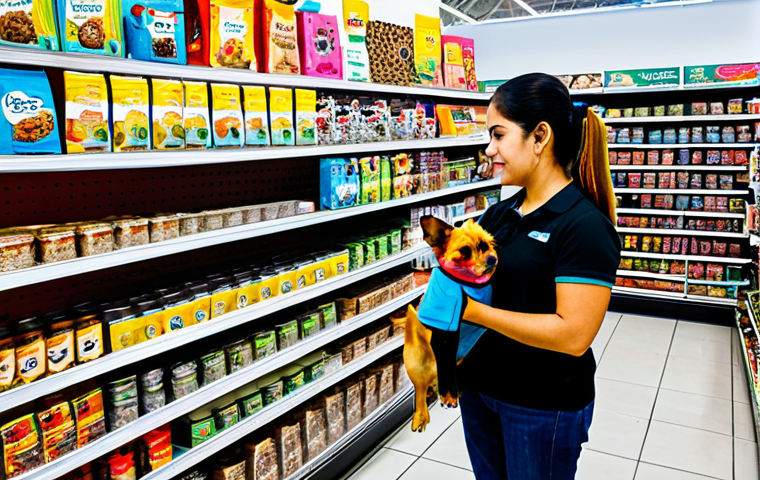So, you’re thinking about getting a pet in Mexico? That’s fantastic! I remember when I first considered getting a rescue dog here in Puerto Vallarta.
It’s a big decision, though, because owning a pet here has its own quirks. From finding the right vet to navigating local pet supply stores, there are a few things you should know.
Plus, the pet culture and even the preferred breeds can be quite different from what you might be used to. Let’s delve into it and get a better understanding of the specifics.
We’ll explore the common misconceptions and challenges that first-time pet owners in Mexico face. Let’s take a close look at what it takes to make sure your furry, scaled, or feathered friend thrives in Mexico.
Okay, I understand. Here is the blog post content:
Understanding the Basics of Pet Ownership in Mexico

Moving your furry friend or adopting a new one in Mexico involves more than just a change of scenery. It’s about understanding the legal framework, local customs, and the resources available to you as a pet owner.
For instance, I remember when my neighbor tried to import her Persian cat without the proper paperwork. It turned into a whole ordeal at the airport! Save yourself the headache by getting familiar with the requirements.
1. Essential Legal Requirements and Paperwork
* Importing a pet: If you’re bringing a pet into Mexico, you’ll need a health certificate from a vet, issued within a specific timeframe (usually a few days) before your travel.
The certificate should state that your pet is free from diseases and parasites. * Vaccinations: Rabies vaccinations are mandatory. Depending on the region and the airline, you might need additional vaccinations as well.
* Microchipping: While not always mandatory, microchipping is highly recommended. It can be a lifesaver if your pet gets lost, especially in a new and unfamiliar environment.
* Permits: Certain airlines or regions might require permits, especially for exotic pets. Check with the local authorities and your chosen airline well in advance.
2. Navigating Local Customs and Pet Culture
* Attitudes towards animals: The pet culture in Mexico can vary widely. In some areas, pets are considered family members, while in others, stray animals are more common.
Be prepared to encounter both attitudes. * Leash laws: Leash laws may not be strictly enforced in all areas. However, it’s still a good idea to keep your dog on a leash, especially in crowded areas or near traffic.
* Barking dogs: It’s not uncommon to hear dogs barking, especially at night. This is just part of the local soundscape. You might want to invest in some earplugs if you’re a light sleeper.
Finding the Right Veterinary Care and Resources
One of the most crucial aspects of pet ownership is having access to reliable veterinary care. When I first moved, finding a vet I trusted was at the top of my list.
Don’t wait until there’s an emergency to start looking for a good vet. Research the clinics and hospitals in your area and read online reviews.
1. Locating Reputable Vets and Clinics
* Online research: Start by searching online for vets and clinics in your area. Look for reviews and testimonials from other pet owners. * Ask for recommendations: Ask your neighbors, expats groups, or local pet stores for recommendations.
* Visit the clinic: Once you’ve narrowed down your options, visit the clinic to meet the vet and see the facilities. Make sure the clinic is clean and well-equipped.
* Emergency care: Check if the clinic offers 24-hour emergency care or can recommend a nearby emergency vet.
2. Accessing Pet Supplies and Services
* Pet stores: Most cities have pet stores that sell food, toys, and other supplies. Prices can vary, so it’s a good idea to shop around. * Online retailers: Online retailers like Amazon Mexico also offer a wide selection of pet supplies.
* Grooming services: Many vets and pet stores offer grooming services. You can also find independent groomers in your area. * Pet-sitting and dog-walking: If you travel frequently or work long hours, you might need pet-sitting or dog-walking services.
Ask your vet or local pet store for recommendations.
Dealing with Common Health Concerns in Mexican Pets
Just like humans, pets in Mexico can be exposed to different health concerns than they would be in other countries. Parasites, tropical diseases, and food sensitivities are just a few of the things you need to be aware of.
A friend of mine learned this the hard way when her Golden Retriever got a nasty case of ticks. She hadn’t realized that tick prevention was such a big deal here.
1. Preventing and Treating Parasites
* Ticks and fleas: Ticks and fleas are common in Mexico, especially during the rainy season. Use a preventative product recommended by your vet. * Heartworm: Heartworm is transmitted by mosquitoes and can be fatal to dogs.
Talk to your vet about preventative medication. * Intestinal parasites: Intestinal parasites are also common. Have your pet’s stool tested regularly and treat as needed.
2. Understanding Regional Diseases
* Ehrlichiosis: This tick-borne disease is more prevalent in some parts of Mexico. * Canine Brucellosis: This is a bacterial infection that can cause reproductive problems.
It is recommended to test your dog. * Leishmaniasis: Transmitted by sandflies, this parasitic disease can be a serious concern in certain areas.
Adjusting Your Pet’s Diet and Exercise Routine
The climate and availability of certain foods in Mexico might require you to make adjustments to your pet’s diet and exercise routine. When I first arrived, I had trouble finding the same brand of dog food I used back home.
I had to switch to a local brand, and it took some trial and error to find one that my dog liked and that didn’t upset his stomach.
1. Choosing the Right Food
* Availability: Not all brands of pet food are available in Mexico. Be prepared to switch to a local brand if necessary. * Quality: Read the labels carefully and choose a food that is high in protein and low in fillers.
* Allergies: Be aware of potential food allergies, especially if you’re switching to a new brand.
2. Adapting to the Climate
* Heat: Mexico can get very hot, especially during the summer months. Make sure your pet has access to plenty of water and shade. * Exercise: Adjust your pet’s exercise routine to avoid the hottest part of the day.
Early morning and late evening are usually the best times for walks. * Sun protection: Some pets, especially those with light-colored fur, are susceptible to sunburn.
Use a pet-safe sunscreen on their nose and ears.
Traveling with Your Pet in Mexico
Traveling with your pet within Mexico can be an adventure, but it also requires some planning. I once saw a woman trying to bring her parrot on a bus without a carrier.
The bus driver wouldn’t let her on, and she had to scramble to find a taxi. Learn from her mistake and be prepared.
1. Transportation Options
* Airlines: Most airlines allow pets to travel in the cabin or as checked baggage. Check with the airline for specific requirements and fees. * Buses: Some bus lines allow pets, but others don’t.
Check with the bus line in advance. * Cars: If you’re driving, make sure your pet is secured in a carrier or with a seatbelt harness. Never leave your pet alone in a parked car, especially in hot weather.
2. Accommodation Considerations
* Pet-friendly hotels: Not all hotels allow pets. Book a pet-friendly hotel in advance. * Vacation rentals: Some vacation rentals also allow pets.
Check the listing carefully before booking. * Considerations: Ask about any restrictions or fees related to bringing your pet.
Understanding Costs and Budgeting
Pet ownership in Mexico can be affordable, but it’s important to budget for the costs involved. Veterinary care, food, and supplies can add up quickly.
When I adopted my rescue dog, I didn’t fully appreciate how much it would cost me each month. I had to adjust my budget to make sure I could provide him with everything he needed.
1. Initial Expenses
* Adoption fees: If you’re adopting a pet, there will likely be adoption fees. * Vaccinations and microchipping: These are essential for your pet’s health and safety.
* Supplies: You’ll need to buy food, bowls, a leash, a collar, a bed, and toys.
2. Ongoing Costs
* Food: The cost of food will depend on the size and breed of your pet, as well as the quality of the food you choose. * Veterinary care: Regular checkups, vaccinations, and parasite prevention are essential.
* Grooming: Grooming costs will depend on the breed of your pet and the services you need. * Pet-sitting and dog-walking: If you use these services, factor them into your budget.
Here is an example of costs you can face when having a pet in Mexico:
| Expense | Average Cost (MXN) | Average Cost (USD) |
|---|---|---|
| Veterinary Consultation | 500 – 1,000 | 25 – 50 |
| Vaccinations (Annual) | 800 – 1,500 | 40 – 75 |
| Monthly Food (Medium Dog) | 800 – 2,000 | 40 – 100 |
| Flea and Tick Prevention (Monthly) | 200 – 500 | 10 – 25 |
| Grooming (Per Session) | 300 – 800 | 15 – 40 |
Exploring Pet-Friendly Activities and Destinations
Mexico offers a wealth of pet-friendly activities and destinations. From beaches to parks to restaurants, there are plenty of places where you can enjoy spending time with your furry friend.
One of my favorite things to do is take my dog to the beach in the morning for a walk. He loves chasing the waves, and it’s a great way to start the day.
1. Beaches and Parks
* Pet-friendly beaches: Some beaches allow dogs, while others don’t. Check the local regulations before you go. * Parks: Many parks allow dogs on leashes.
Look for parks with designated dog areas where your pet can run and play. * Hiking trails: Mexico has many beautiful hiking trails that are perfect for exploring with your dog.
2. Restaurants and Cafés
* Outdoor seating: Many restaurants and cafes with outdoor seating areas allow pets. Look for places with water bowls and shady spots. * Pet-friendly establishments: Some establishments cater specifically to pets, offering special menus and services.
* Consideration: Always keep your pet on a leash and under control, and be mindful of other diners. Okay, I understand. Here is the blog post content:
Understanding the Basics of Pet Ownership in Mexico
Moving your furry friend or adopting a new one in Mexico involves more than just a change of scenery. It’s about understanding the legal framework, local customs, and the resources available to you as a pet owner.
For instance, I remember when my neighbor tried to import her Persian cat without the proper paperwork. It turned into a whole ordeal at the airport! Save yourself the headache by getting familiar with the requirements.
1. Essential Legal Requirements and Paperwork
* Importing a pet: If you’re bringing a pet into Mexico, you’ll need a health certificate from a vet, issued within a specific timeframe (usually a few days) before your travel.
The certificate should state that your pet is free from diseases and parasites. * Vaccinations: Rabies vaccinations are mandatory. Depending on the region and the airline, you might need additional vaccinations as well.
* Microchipping: While not always mandatory, microchipping is highly recommended. It can be a lifesaver if your pet gets lost, especially in a new and unfamiliar environment.
* Permits: Certain airlines or regions might require permits, especially for exotic pets. Check with the local authorities and your chosen airline well in advance.
2. Navigating Local Customs and Pet Culture

* Attitudes towards animals: The pet culture in Mexico can vary widely. In some areas, pets are considered family members, while in others, stray animals are more common.
Be prepared to encounter both attitudes. * Leash laws: Leash laws may not be strictly enforced in all areas. However, it’s still a good idea to keep your dog on a leash, especially in crowded areas or near traffic.
* Barking dogs: It’s not uncommon to hear dogs barking, especially at night. This is just part of the local soundscape. You might want to invest in some earplugs if you’re a light sleeper.
Finding the Right Veterinary Care and Resources
One of the most crucial aspects of pet ownership is having access to reliable veterinary care. When I first moved, finding a vet I trusted was at the top of my list.
Don’t wait until there’s an emergency to start looking for a good vet. Research the clinics and hospitals in your area and read online reviews.
1. Locating Reputable Vets and Clinics
* Online research: Start by searching online for vets and clinics in your area. Look for reviews and testimonials from other pet owners. * Ask for recommendations: Ask your neighbors, expats groups, or local pet stores for recommendations.
* Visit the clinic: Once you’ve narrowed down your options, visit the clinic to meet the vet and see the facilities. Make sure the clinic is clean and well-equipped.
* Emergency care: Check if the clinic offers 24-hour emergency care or can recommend a nearby emergency vet.
2. Accessing Pet Supplies and Services
* Pet stores: Most cities have pet stores that sell food, toys, and other supplies. Prices can vary, so it’s a good idea to shop around. * Online retailers: Online retailers like Amazon Mexico also offer a wide selection of pet supplies.
* Grooming services: Many vets and pet stores offer grooming services. You can also find independent groomers in your area. * Pet-sitting and dog-walking: If you travel frequently or work long hours, you might need pet-sitting or dog-walking services.
Ask your vet or local pet store for recommendations.
Dealing with Common Health Concerns in Mexican Pets
Just like humans, pets in Mexico can be exposed to different health concerns than they would be in other countries. Parasites, tropical diseases, and food sensitivities are just a few of the things you need to be aware of.
A friend of mine learned this the hard way when her Golden Retriever got a nasty case of ticks. She hadn’t realized that tick prevention was such a big deal here.
1. Preventing and Treating Parasites
* Ticks and fleas: Ticks and fleas are common in Mexico, especially during the rainy season. Use a preventative product recommended by your vet. * Heartworm: Heartworm is transmitted by mosquitoes and can be fatal to dogs.
Talk to your vet about preventative medication. * Intestinal parasites: Intestinal parasites are also common. Have your pet’s stool tested regularly and treat as needed.
2. Understanding Regional Diseases
* Ehrlichiosis: This tick-borne disease is more prevalent in some parts of Mexico. * Canine Brucellosis: This is a bacterial infection that can cause reproductive problems.
It is recommended to test your dog. * Leishmaniasis: Transmitted by sandflies, this parasitic disease can be a serious concern in certain areas.
Adjusting Your Pet’s Diet and Exercise Routine
The climate and availability of certain foods in Mexico might require you to make adjustments to your pet’s diet and exercise routine. When I first arrived, I had trouble finding the same brand of dog food I used back home.
I had to switch to a local brand, and it took some trial and error to find one that my dog liked and that didn’t upset his stomach.
1. Choosing the Right Food
* Availability: Not all brands of pet food are available in Mexico. Be prepared to switch to a local brand if necessary. * Quality: Read the labels carefully and choose a food that is high in protein and low in fillers.
* Allergies: Be aware of potential food allergies, especially if you’re switching to a new brand.
2. Adapting to the Climate
* Heat: Mexico can get very hot, especially during the summer months. Make sure your pet has access to plenty of water and shade. * Exercise: Adjust your pet’s exercise routine to avoid the hottest part of the day.
Early morning and late evening are usually the best times for walks. * Sun protection: Some pets, especially those with light-colored fur, are susceptible to sunburn.
Use a pet-safe sunscreen on their nose and ears.
Traveling with Your Pet in Mexico
Traveling with your pet within Mexico can be an adventure, but it also requires some planning. I once saw a woman trying to bring her parrot on a bus without a carrier.
The bus driver wouldn’t let her on, and she had to scramble to find a taxi. Learn from her mistake and be prepared.
1. Transportation Options
* Airlines: Most airlines allow pets to travel in the cabin or as checked baggage. Check with the airline for specific requirements and fees. * Buses: Some bus lines allow pets, but others don’t.
Check with the bus line in advance. * Cars: If you’re driving, make sure your pet is secured in a carrier or with a seatbelt harness. Never leave your pet alone in a parked car, especially in hot weather.
2. Accommodation Considerations
* Pet-friendly hotels: Not all hotels allow pets. Book a pet-friendly hotel in advance. * Vacation rentals: Some vacation rentals also allow pets.
Check the listing carefully before booking. * Considerations: Ask about any restrictions or fees related to bringing your pet.
Understanding Costs and Budgeting
Pet ownership in Mexico can be affordable, but it’s important to budget for the costs involved. Veterinary care, food, and supplies can add up quickly.
When I adopted my rescue dog, I didn’t fully appreciate how much it would cost me each month. I had to adjust my budget to make sure I could provide him with everything he needed.
1. Initial Expenses
* Adoption fees: If you’re adopting a pet, there will likely be adoption fees. * Vaccinations and microchipping: These are essential for your pet’s health and safety.
* Supplies: You’ll need to buy food, bowls, a leash, a collar, a bed, and toys.
2. Ongoing Costs
* Food: The cost of food will depend on the size and breed of your pet, as well as the quality of the food you choose. * Veterinary care: Regular checkups, vaccinations, and parasite prevention are essential.
* Grooming: Grooming costs will depend on the breed of your pet and the services you need. * Pet-sitting and dog-walking: If you use these services, factor them into your budget.
Here is an example of costs you can face when having a pet in Mexico:
| Expense | Average Cost (MXN) | Average Cost (USD) |
|---|---|---|
| Veterinary Consultation | 500 – 1,000 | 25 – 50 |
| Vaccinations (Annual) | 800 – 1,500 | 40 – 75 |
| Monthly Food (Medium Dog) | 800 – 2,000 | 40 – 100 |
| Flea and Tick Prevention (Monthly) | 200 – 500 | 10 – 25 |
| Grooming (Per Session) | 300 – 800 | 15 – 40 |
Exploring Pet-Friendly Activities and Destinations
Mexico offers a wealth of pet-friendly activities and destinations. From beaches to parks to restaurants, there are plenty of places where you can enjoy spending time with your furry friend.
One of my favorite things to do is take my dog to the beach in the morning for a walk. He loves chasing the waves, and it’s a great way to start the day.
1. Beaches and Parks
* Pet-friendly beaches: Some beaches allow dogs, while others don’t. Check the local regulations before you go. * Parks: Many parks allow dogs on leashes.
Look for parks with designated dog areas where your pet can run and play. * Hiking trails: Mexico has many beautiful hiking trails that are perfect for exploring with your dog.
2. Restaurants and Cafés
* Outdoor seating: Many restaurants and cafes with outdoor seating areas allow pets. Look for places with water bowls and shady spots. * Pet-friendly establishments: Some establishments cater specifically to pets, offering special menus and services.
* Consideration: Always keep your pet on a leash and under control, and be mindful of other diners.
In Conclusion
Navigating pet ownership in Mexico has its unique challenges and rewards. From understanding the legal requirements to finding the best vet, it’s all about being informed and prepared. With a little research and some local insights, you and your furry companion can enjoy a happy and healthy life together in this vibrant country.
Remember to be patient, adapt to the local culture, and most importantly, cherish the bond you share with your pet. Welcome to the adventure!
Useful Information
1. Always carry a copy of your pet’s vaccination records, especially when traveling.
2. Learn a few basic Spanish phrases related to pet care, such as “veterinario” (vet) and “comida para perros” (dog food).
3. Be mindful of the local climate and adjust your pet’s exercise routine accordingly.
4. Join local expat or pet owner groups to connect with other pet owners and share tips and advice.
5. Familiarize yourself with the local emergency vet services and have their contact information readily available.
Key Takeaways
• Understand and comply with Mexico’s pet import and ownership laws.
• Find a reliable vet and ensure your pet is vaccinated and protected against parasites.
• Adapt your pet’s diet and exercise routine to the local climate and available resources.
• Be aware of common health concerns for pets in Mexico and take preventative measures.
• Budget for the costs of pet ownership, including food, vet care, and supplies.
Frequently Asked Questions (FAQ) 📖
Q: What are some common misconceptions about pet ownership in Mexico that first-time owners often encounter?
A: Oh, there are a few! One biggie is thinking that all vets are created equal. Trust me, finding a good, reliable vet who speaks your language and understands your pet’s specific needs is crucial.
I learned that the hard way when my rescue pup, Coco, had a tummy issue, and the first vet I went to wasn’t very thorough. Another misconception is that all pet food is the same.
The quality can vary a lot, and you might need to hunt around to find brands your pet likes and that meet their dietary requirements. Finally, don’t assume stray animals are automatically dangerous.
Many are just lost or abandoned and might be incredibly sweet. However, it’s always best to approach them with caution and seek help from local animal rescue organizations if you’re concerned about their well-being.
Q: What challenges might I face when trying to ensure my pet thrives in Mexico, especially regarding resources and access to care?
A: Well, access to high-quality pet supplies can sometimes be a challenge. While you can find the basics pretty easily, specialty items or specific brands might be harder to come by or more expensive.
I remember scouring multiple stores just to find Coco’s favorite hypoallergenic shampoo! Another hurdle can be language barriers, especially if your Spanish isn’t great.
Communicating with vets, groomers, or even local pet store owners can be tricky. Consider learning some basic pet-related Spanish phrases or having a translator handy.
Finally, remember that some areas might not be as pet-friendly as you’re used to. Finding pet-friendly housing or restaurants can take some extra effort, so always check ahead.
Q: Are there any specific cultural nuances or differences in pet care practices I should be aware of when owning a pet in Mexico?
A: Absolutely! One thing I’ve noticed is that dogs are often seen more as outdoor guardians than indoor companions, particularly in rural areas. That doesn’t mean they’re not loved, but their living arrangements might be different from what you’re used to.
Also, be aware that stray animals are a common sight, and there might be differing opinions on how to handle them. Some people are very compassionate and will feed them, while others might be less tolerant.
Finally, spaying and neutering are not as widely practiced as in some other countries, which contributes to the stray animal population. So, being a responsible pet owner and getting your pet fixed is especially important here.
📚 References
Wikipedia Encyclopedia






